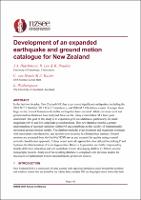Development and implications of an expanded national earthquake catalogue for New Zealand

Download
Date
2021-04-14Authors
Hutchinson, Jesse
Lee, Robin
Bradley, Brendon
Van Houtte, Chris
Kaiser, Anna
Wotherspoon, Liam
Metadata
Show full item recordAbstract
In the last two decades, New Zealand (NZ) has experienced significant earthquakes, including the 2010 M 7.2 Darfield, 2011 M 6.2 Christchurch, and 2016 M 7.8 Kaikōura events. Amongst these large events, tens of thousands of smaller earthquakes have occurred. While previous event and ground-motion databases have analyzed these events, many events below M 4 have gone undetected. The goal of this study is to expand on previous databases, particularly for small magnitude (M<4) and low-amplitude ground motions. This new database enables a greater understanding of regional variations within NZ and contributes to the validity of internationally developed ground-motion models. The database includes event locations and magnitude estimates with uncertainty considerations, and tectonic type assessed in a hierarchical manner. Ground motions are extracted from the GeoNet FDSN server and assessed for quality using a neural network classification approach. A deep neural network approach is also utilized for picking P and S phases for determination of event hypocentres. Relative hypocentres are further improved by double-difference relocation and will contribute toward developing shallow (< 50 km) seismic tomography models. Analysis of the resulting database is compared with previous studies for discussion of implications toward national hazard prediction models.
